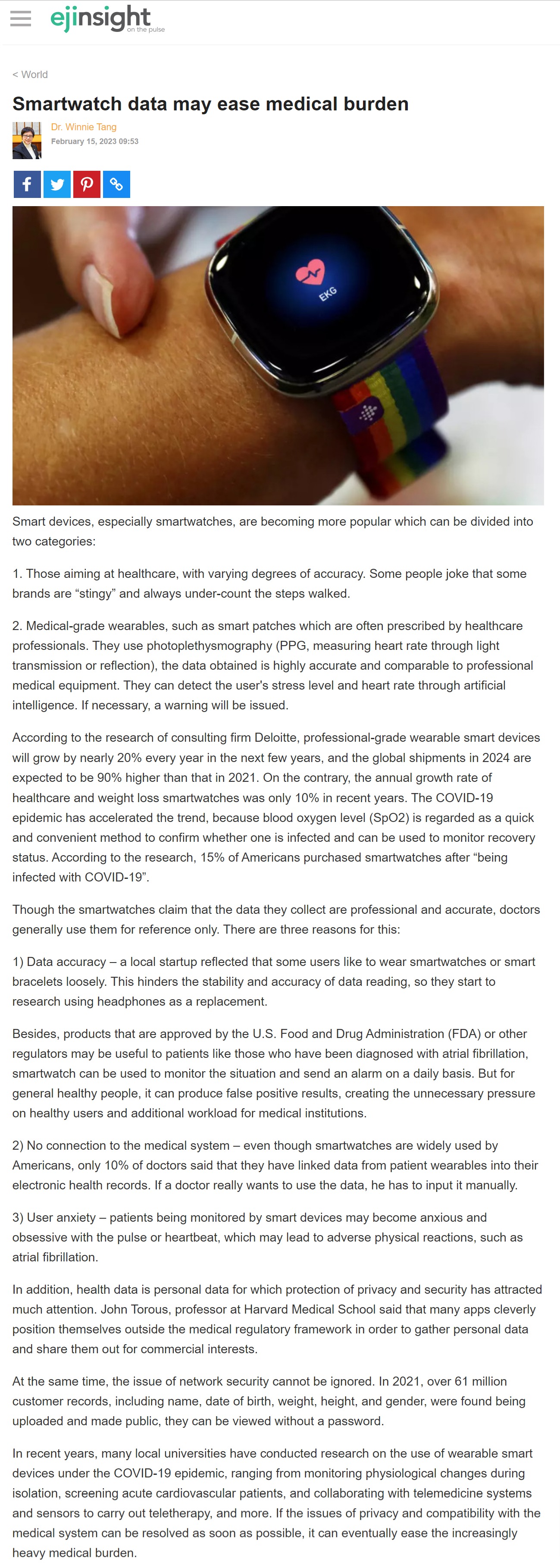網上版請按此

Smartwatch data may ease medical burden
Smart devices, especially smartwatches, are becoming more popular which can be divided into two categories:
1. Those aiming at healthcare, with varying degrees of accuracy. Some people joke that some brands are "stingy" and always under-count the steps walked.
2. Medical-grade wearables, such as smart patches which are often prescribed by healthcare professionals. They use photoplethysmography (PPG, measuring heart rate through light transmission or reflection), the data obtained is highly accurate and comparable to professional medical equipment. They can detect the user's stress level and heart rate through artificial intelligence. If necessary, a warning will be issued.
According to the research of consulting firm Deloitte, professional-grade wearable smart devices will grow by nearly 20% every year in the next few years, and the global shipments in 2024 are expected to be 90% higher than that in 2021. On the contrary, the annual growth rate of healthcare and weight loss smartwatches was only 10% in recent years. The COVID-19 epidemic has accelerated the trend, because blood oxygen level (SpO2) is regarded as a quick and convenient method to confirm whether one is infected and can be used to monitor recovery status. According to the research, 15% of Americans purchased smartwatches after "being infected with COVID-19".
Though the smartwatches claim that the data they collect are professional and accurate, doctors generally use them for reference only. There are three reasons for this:
1) Data accuracy – a local startup reflected that some users like to wear smartwatches or smart bracelets loosely. This hinders the stability and accuracy of data reading, so they start to research using headphones as a replacement.
Besides, products that are approved by the U.S. Food and Drug Administration (FDA) or other regulators may be useful to patients like those who have been diagnosed with atrial fibrillation, smartwatch can be used to monitor the situation and send an alarm on a daily basis. But for general healthy people, it can produce false positive results, creating the unnecessary pressure on healthy users and additional workload for medical institutions.
2) No connection to the medical system – even though smartwatches are widely used by Americans, only 10% of doctors said that they have linked data from patient wearables into their electronic health records. If a doctor really wants to use the data, he has to input it manually.
3) User anxiety – patients being monitored by smart devices may become anxious and obsessive with the pulse or heartbeat, which may lead to adverse physical reactions, such as atrial fibrillation.
In addition, health data is personal data for which protection of privacy and security has attracted much attention. John Torous, professor at Harvard Medical School said that many apps cleverly position themselves outside the medical regulatory framework in order to gather personal data and share them out for commercial interests.
At the same time, the issue of network security cannot be ignored. In 2021, over 61 million customer records, including name, date of birth, weight, height, and gender, were found being uploaded and made public, they can be viewed without a password.
In recent years, many local universities have conducted research on the use of wearable smart devices under the COVID-19 epidemic, ranging from monitoring physiological changes during isolation, screening acute cardiovascular patients, and collaborating with telemedicine systems and sensors to carry out teletherapy, and more. If the issues of privacy and compatibility with the medical system can be resolved as soon as possible, it can eventually ease the increasingly heavy medical burden.
Dr. Winnie Tang
Adjunct Professor, Department of Computer Science, Faculty of Engineering; Department of Geography, Faculty of Social Sciences; and Faculty of Architecture, The University of Hong Kong